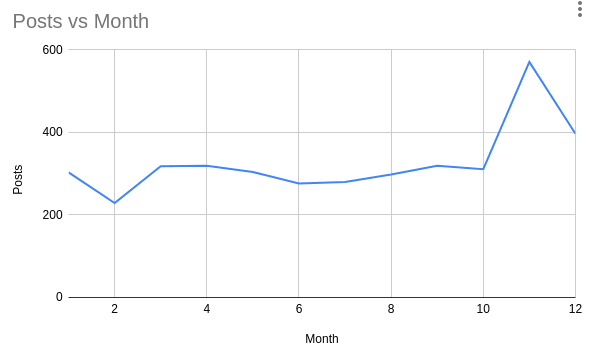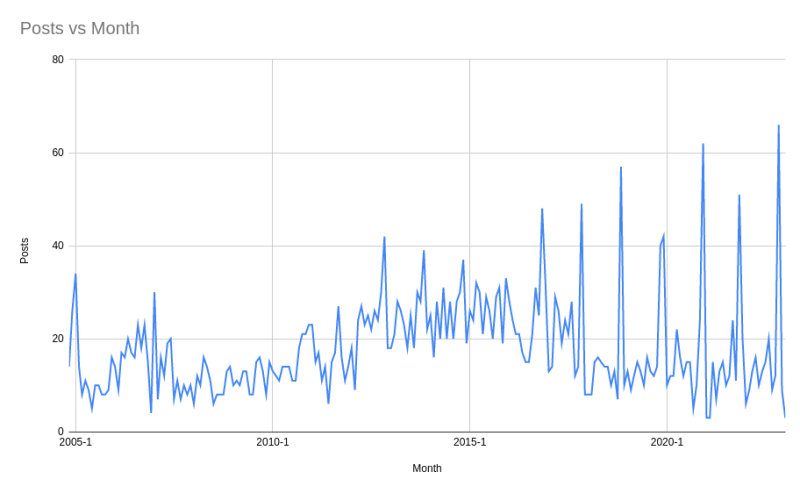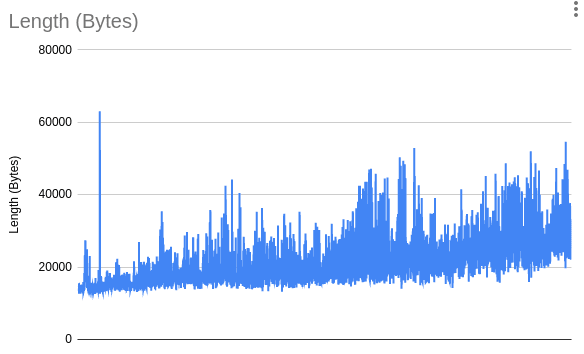Last week I checked the (primary) AWS blog. I went through all the articles from the welcome post in 2004 until the very last one. I did not read all of them. I just collected some data using Python and a Bash script.
Random Numbers
Let’s start with some random numbers. There are until today 3925 posts.
The year with the most posts? 2015 with 320 posts, almost one a day. AWS then realized more “secondary” blogs were needed. You now have more content to read, but spread across multiple blogs.
Top month? Well, November of course, 571 posts. The re:Invent effect, with significant spikes in the last few years. Quieter month? February with 229.
I plot the month-by-month over the years we can see how the role of the primary AWS blog has shifted and how it is impacted by announcements in Vegas.
The top day ever? A re:Invent day (December 3rd, 2019) with 27 articles.
Top author? Jeff Barr, of course. He appears as the author of 80% of the posts (3136) but this includes a small number of guest posts and posts that in earlier years were coming from other authors but were posted by Jeff himself.
Frugality or Complexity?
I love discussing useless numbers but you might wonder, what was I looking for?
Trigger by jeff Barr’s recent “Leadership Principles for AWS News Bloggers”, I was curious about how much longer (and usually more complex) posts became over the years.
As an InfoQ editor and as a cloud architect, I struggle to keep myself up-to-date even with just the biggest announcements and the main AWS blog alone. Jeff Barr writes:
Be frugal with your own time and with that of your readers (…) Keep posts concise and don’t spend the readers’ time unnecessarily.
Without any complex analysis, I just checked the length of the page in bytes, removing the fixed size of the page’s look and feel. With a few exceptions aside, including a Transcript of Jeff Barr’s Web 2.0 Interview, all the longest articles are very recent.
Posts are getting longer. Are the authors not frugal enough? The platform gets more and more updates and features, increasing the complexity of the announcements too.
S3 and Route53
Let’s compare a couple of articles, from the early times and from recent posts.
Introducing Amazon Route 53 Application Recovery Controller (2021)
Almost 3000 words and over 30 screenshots and diagrams are required to describe how the new feature of Route53 works.
Amazon Route 53 – The AWS Domain Name Service (2010)
About 600 words , not a single screenshot, and a rudimental Route53 logo were enough to announce the service and its main features.
What about an even shorter post?
Amazon S3 (2006)
Just over 200 words , one of the shortest posts ever, were enough for arguably one of the most important announcements in the history of AWS, Amazon S3. Jeff Barr had (literally) a plane to catch:
I’ve got to catch a plane to Silicon Valley in a few minutes, or I’d write a lot more.
Amazon S3 Encrypts New Objects By Default (2023)
By comparison, the most recent announcement about S3, the change in the default of a checkbox, required four times more words.
I wonder how long would be an S3 roundup 17 years later.
Conclusions
Long gone are the days of deployments of web applications relying solely on EC2, RDS, and S3. AWS now claims “over 200 fully featured services from data centers globally” each with multiple options, pricing models, and deployment options.
There’s never been a better time to be a developer. But there’s never been a harder time to make the correct choices. Even following just the primary AWS blog requires a lot of effort. And it is only one of the different blogs offered by the cloud provider.
There is nothing wrong with the authors, I am sure they try to be as frugal as possible but it is getting harder to keep ourselves up to date.
Enough, we are at just over 700 words already.
The post My Journey Through the AWS Blog: Lessons Learned and Random Statistics appeared first on cloudiamo.com.










Top comments (0)